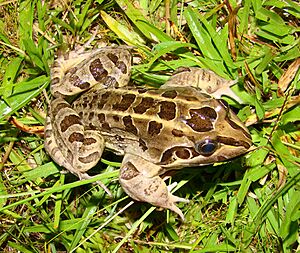Leptodactylus latrans facts for kids
Quick facts for kids Leptodactylus latrans |
|
|---|---|
 |
|
| Conservation status | |
| Scientific classification | |
| Synonyms | |
|
The Leptodactylus latrans is a type of frog that belongs to the Leptodactylidae family. It is also known by many common names, like rana criolla, sapo-rana llanero, butter frog, and lesser foam frog. This frog is found in many parts of South America, especially east of the Andes mountains, and also on the islands of Trinidad and Tobago.
Where These Frogs Live (Habitat)
The Leptodactylus latrans is a very common frog in the places where it lives. You can find it in many different kinds of environments. These include wet areas like swamps, open grassy lands called savannahs, and thick tropical forests.
These frogs are quite adaptable. They can live in areas that have been changed by humans, like gardens and even busy city areas. They like to breed in temporary water spots, such as small ponds or areas that flood after rain.
Life Cycle and Reproduction
When it's time to lay eggs, the Leptodactylus latrans frog builds a special home for its babies. It creates a foam nest in temporary water bodies like ponds or floodplains. This foam nest helps protect the eggs.
Sometimes, one of the parent frogs will guard the tadpoles. This is usually the female frog. She will stay near the nest and protect her young from other animals that might try to eat them. This care helps the tadpoles grow safely.
Understanding Their Family Tree (Taxonomy)
The scientific name Leptodactylus latrans was given to this frog in 1815. However, scientists sometimes find it tricky to study this particular frog. This is because it is thought to be part of a "species complex".
A species complex means that what we currently call Leptodactylus latrans might actually be several very similar but different species. Scientists are still studying these frogs to figure out if they should be split into more distinct types.


